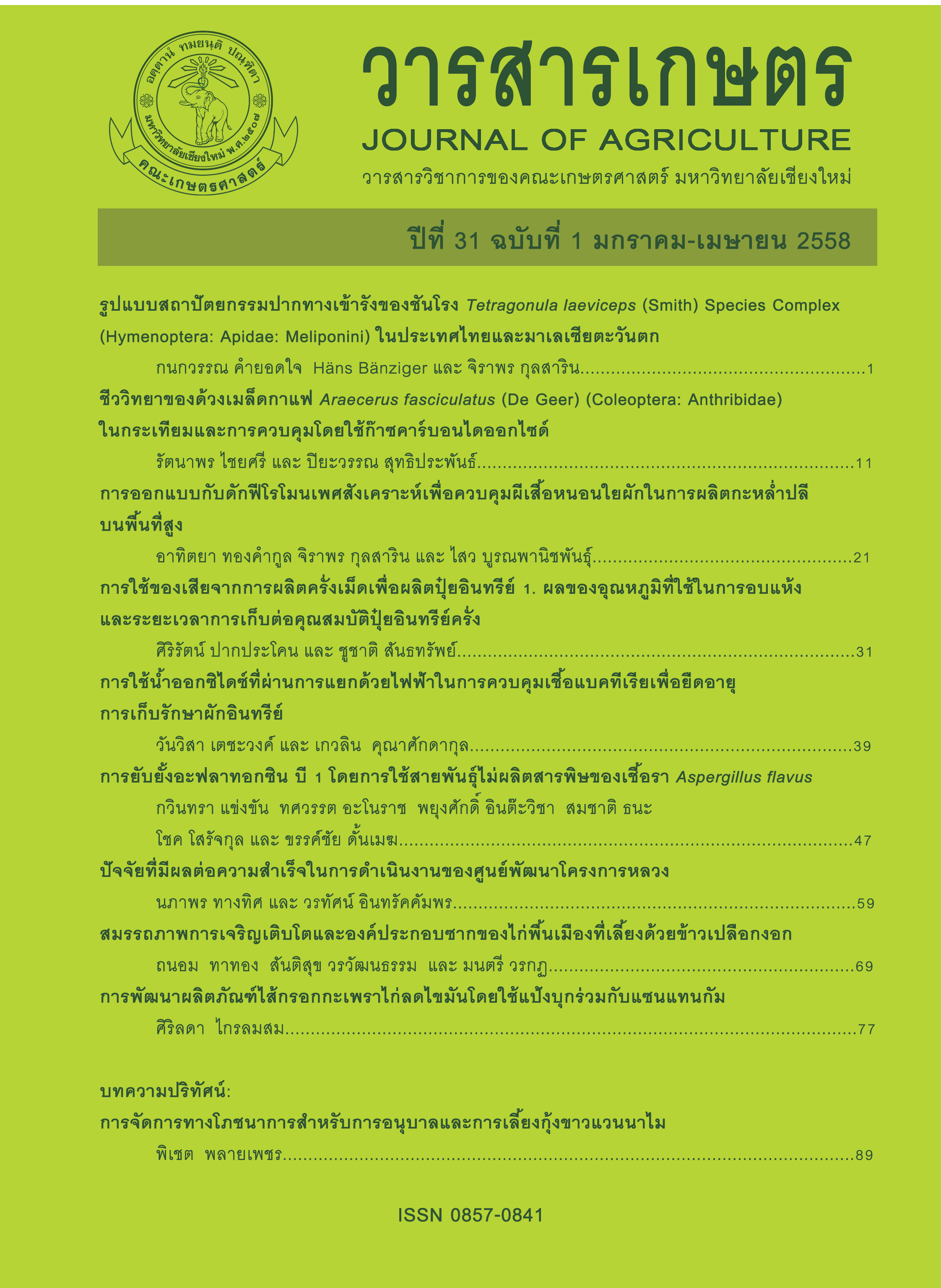Using Electrolyzed Oxidizing Water in Controlling Bacteria for Prolonging Storage-life of Organic Vegetables
Main Article Content
Abstract
The purpose of this study was to examine the effects of electrolyzed oxidizing water (EO water) on reduction of rot disease in organic vegetables. EO water was produced in various concentrations of NaCl at 0.00625, 0.0125, 0.025, 0.05, 0.1, 0.2, 0.3, 0.4 and 0.5 percent. Then the free chlorine concentrations and pH values were measured in the range of 0.40-137.00 ppm and 3.65-4.11, respectively. While the electrolyte conductivity (EC) showed in the range of 0.49-6.23 mS/cm. Erwinia carotovora, bacterial pathogens of soft rot disease were isolated from Chinese cabbage and were used for inhibitory effect trials of EO water. Bacterial suspension cells were soaked for 1 and 5 min into each concentration of EO water. After incubated on NA medium for 24-48 hrs., results showed that the bacterial growth was completely inhibited except the trial of EO water at concentration of 0.00625 percent which was found very few colonies grew up. In addition, magnification observed on the bacterial cell size, revealed that those the EO treated trials showed smaller size than in the control (distilled water) treatment, except in the concentrations of 0.00625 and 0.0125 percent. Applications of various concentrations of EO water for reduction of soft rot disease were done on organic vegetables (Chinese cabbage and Cos lettuce) and the results showed that the 0.3 percent EO treatment was the best to reduce soft rot incident. Then, soft rot inhibitory effect of EO water at 0.3 percent was compared to other disinfectants; Ozone water (0.02 percent), potassium permanganate (0.05 g/l), sodium bicarbonate (2.5 g/l) and chlorinated water (0.02 percent). The results revealed that EO water could reduce soft rot disease and prolong shelf-life of organic vegetables (Chinese cabbage and Cos lettuce) better than other disinfectant solutions.
Article Details
References
ชนัญชิดา สิงคมณี กานดา หวังชัย และ จำนง อุทัยบุตร. 2551. การใช้โอโซนและน้ำอิเล็กโทรไลต์ในการควบคุมเชื้อรา Penicillium digitatum ของส้มพันธุ์สายน้ำผึ้ง. วารสารวิทยาศาสตร์เกษตร 39(3) พิเศษ: 257-260.
วิลาวรรณ์ เชื้อบุญ. 2551. ลักษณะและการทดสอบประสิทธิภาพของแบคทีเรียที่มีประโยชน์ควบคุมเชื้อ Erwinia carotovora subsp. carotovora สาเหตุโรคเน่าเละของกะหล่ำดอก. วิทยานิพนธ์วิทยาศาสตรมหาบัณฑิต. มหาวิทยาลัย เกษตรศาสตร์, กรุงเทพฯ. 121 หน้า.
ศูนย์เทคโนโลยีโลหะและวัสดุแห่งชาติ. 2556. นวัตกรรมยืดอายุผักผลไม้บรรจุภัณฑ์ฉลาด. (ระบบออนไลน์). แหล่งข้อมูล: http://www.mtec.or.th/index.php/2013-05-29-09-06-21/2013-05-29-09-39-49/84- (2 สิงหาคม 2557).
สุจริตพรรณ บุญมี. 2556. ผลของน้ำออกซิไดส์ที่ผ่านการแยกด้วยไฟฟ้าต่อการลดโรคราแป้งในพืชวงศ์แตง. วารสารเกษตร (29)3: 257-266.
Bearson, S., B. Bearson and J. W. Foster. 1997. Acid stress responses in enterobacteria. pp. 135-164. In: S. Salminen and A. Von Wright (eds.). Lactic Acid Bacteria. Marcel Dekker, Inc. New York.
Fuller, R. 1989. Probiotics in human and animals. Journal of Applied Bacteriology 66: 1430-1434.
Hoon, P., Y. C. Hung and D. Chung. 2004. Effects of chlorine and pH on efficacy of electrolyzed water for inactivating Escherichia coli O157:H7 and Listeria monocytogenes. Food Microbiology 91: 13-18.
Johnson T. R. and C. L. Case. 2013. Koch’s Postulates. Laboratory experiments in microbiology, Tenth Edition. 317-325. (Online). Available: http://www.learningace.com/doc/7755731/d0da6c21dc5ca6eca71df599500bea97/40-koch-s-postulates (August 18, 2014).
Muhammad, I. A., Y. Seo, S. Oshits and Y. Kawagoe. 2002. Disinfection effects of electrolyzed oxidixing water on suppressing fruit rot of pear caused by Botryosphaeria berengeriana. Food Research International 35: 657-664.
Sakurai, Y. M., N. Y. Sato and K. Sato. 2003. Endoscope contamination from HBV- and HCV- positive patients and evaluation of a cleaning/disinfecting method using strongly acidic electrolyzed water. Digestive Endoscopy 15: 19-24.
U. S. Food and Drug Administration. 2001. Microbiological safety of controlled and modified atmosphere packaging of fresh and fresh-cut produce. In Analysis and Evaluation of Preventive Control Measures for the Control and Reduction/Elimination of Microbial Hazards on Fresh and Fresh-cut Produce. (Online). Available: http://www.fda.gov (June 3, 2014).

